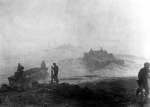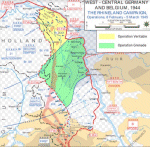
1018156001 |
104k |
Namesake
Rhineland - Rhineland (World War II), 1945. Before the last of the German attackers had been driven out of the Ardennes bulge, the Allies had resumed their
offensive against the Siegfried Line. Progress was so slow, however, that a large scale effort became necessary to affect a breakthrough to the Rhine Valley. On
February 8 the Canadian First Army (Henry Crerar) launched Operation Veritable, a major attack southeast from Nijmegen, Holland, between the Meuse and the Rhine.
The latter was reached on February 14. A converging thrust by the U.S. Ninth Army (William Simpson), called Operation Grenade, crossed the Roer River on February
23. The two advances linked up at Geldern, Germany, on March 3. Two days later the Allies had pressed to the Rhine from opposite Dusseldorf northward, leaving
only a small German bridgehead at Xanten-Wesel. The Canadians eliminated this pocket on March 10. Meanwhile, to the south, the left wing of the U.S. First Army 57
(Courtney Hodges) attacked toward Cologne on February 23 to cover the Ninth Army's right flank. This offensive swept across the Rhine plain, while the U.S.
Third Army of Gen. George Patton punched its way through the Siegfried Line north of the Moselle River. On the central front the rest of the First Army and the
Third Army, both under the group command of Gen. Omar Bradley, launched a broad attack on March 5 toward the middle Rhine (Operation Lumberjack). By
March 10 the Americans had closed to the river from Coblenz northward Ibmugh Bonn and Cologne (which fell March 7), to link up with the Canadians at Wesel.
The rapid advance to the Rhine yielded a surprising and rich dividend. On March 7 the U.S. 9th Armored Division discovered the railroad bridge at Remagen still
standing. (It was the only Rhine bridge not demolished by the Germans.) In a daring gamble, leading elements dashed across the Rhine and seized a bridgehead
on the east bank. Gen. Dwight Eisenhower, supreme Allied commander in Europe, ordered the new break-through hurriedly reinforced. Despite German counterattacks
and determined efforts to wreck the bridge, Hodges rushed three corps (III, V, VII) across the river by bridge, pontoon, and ferry. By March 21 the bridgehead had
grown to 20 miles long and 8 miles deep. (The Remagen success caused the Allies to shift the main axis of their attack found Field Marshal Sir Bernard Montgomery's
northern group of armies to Bradley's central force.) During the Remagen bridgehead build-up, the U.S. General Jacob Devers' Sixth Army Group launched its own
advance to the Rhine (Operation Undertone). On March 15 the right wing of Patton's Third Army attacked south across the Moselle River into the Saar. Two
days later Gen. Alexander Patch's U.S. Seventh Army began hammering through the Siegfried Line, headed northeast. By March 21 the joint U.S. offensive had crushed
all German opposition west of the Rhine except for a shrinking foothold around Landau. Then on March 22 Patton's 5th Infantry Division wheeled from south to
east and plunged across the Rhine at Oppenheim. Encouraged by light opposition in this area, the VIII Corps bridged the river at Boppard, 40 miles to the north, on
March 24. Germany's last natural defensive barrier had now been breached in three places on Bradley's front. The Rhineland battle inflicted a major defeat on three
Nazi army groups-Jobannes Blaskowitz in the north, Walther Model in the center, Hausser in the south. Some 60,000 Germans were killed or wounded and almost
250,000 captured. This heavy toll, plus the loss of much heavy equipment, ruined the Nazi chances of holding the Allied armies at the Rhine. Americans killed in
action totaled 6,570; British and Canadian deaths were markedly fewer.
Photo - US 9th Army amphibious vehicles cross the Rhine under a smokescreen, March 1945. National Army Museum, UK.
Map - West-Central Germany and Belgium, 1944. The Rhineland Campaign, 8 February to 5 March 1945
| Tommy Trampp |






